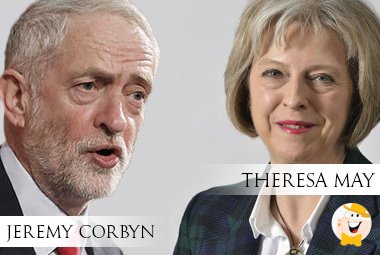
The UK General Election is taking place, and I think that there is some serious value on the betting lines right now. In addition to voters and political enthusiasts, these elections also get the attention of countless punters from around the world (except the United States where such betting is technically illegal---BOO!) who literally put their money where their mouths are on the candidates/results they think will come to fruition.
In recent years, we have seen some serious polling misses pan out well for savvy punters. The most recent example, of course, was President Donald Trump winning the 2016 U.S. Presidential Election. Another recent surprise was the decision to, “Leave,” the European Union in the Brexit vote.
It is typically inadvisable to make a ‘Rule,’ based on just a handful of events, but one cannot help but notice all three of these major, ‘Surprises,’ shorted the Conservatives in terms of what was expected based on the polls.
One significant difference in this Election, however, is it was the Conservative interests (in general terms) that were gaining ground as voting day got closer and closer rather than the Liberal interests. For example, Clinton was ahead of Donald Trump by as high as double digits in a few polls during the months leading up to the election, but a number of factors swung the polling back to Trump.
Granted, Trump NEVER led in the polling averages, but when we talk about, “Betting Value,” we are talking about the odds against the probability of winning, NOT the probability of winning being over 50%. I had written a couple articles to the effect that there was some serious value on the Trump side of the betting lines, but that was not because he was ever more likely than not to win.
When it came to the Brexit vote, (while not a vote strictly on party lines), it was the Tory Party who favored leaving the European Union. Once again, in the build-up to the vote, the, ‘Leave,’ side closed a pretty substantial gap in the polling averages. While it would seem that many, ‘Undecideds,’ from early on in the polling broke toward, ‘Leave,’ even that wasn’t enough to sway the results from the early polling to where they finished.
However, with Brexit, you once again had a situation in which the, ‘Leave,’ had made a charge in the days leading up to the vote. In fact, if you compare the polling average charts from each of these two sites:
https://ig.ft.com/sites/brexit-polling/
While they were at different times and had to do with completely different matters in different countries, they look remarkably similar to one another!

Of course, we’re not going to make any assumptions about two votes in which the result was the opposite of expected, but within the expected margin of error for polling as compared to the final polling averages. The one thing that we could point out is that, if there can be considered to be such a thing as, ‘Momentum,’ the Conservative side of each of those votes had the momentum going in.
With this wave of Parliamentary races happening in the U.K., the trend is pretty clearly the opposite. The Tories started with an incredible lead early on, over fifteen points in the polling averages, but that lead has dwindled fairly steadily over the last couple of months.
That has nothing to do with the Tories losing support, on the contrary, they have gained half a percentage point in the polling averages compared to where they stood just two months ago. The major change in this series of elections has been parties such as the United Kingdom Independent Party (UKIP), and to a lesser extent, the Liberal Democrats (LD), throw their support behind the Labour Party to take out the Conservative Tory Party.
On April 1st of this year, the LD’s and UKIP were at 10.1% and 10.2% support, respectively, in the polling averages. Many pundits also link the decline to Theresa May triggering Article 50 which initiates the process of the United Kingdom leaving the European Union, but is important to remember that there was no actual decline. The other parties have simply rallied with the Labour Party, which perhaps to a slightly lesser extent, probably would have happened anyway.
At that time, the Labour Party has only 26.8% of the polling average. They now have 37% (down from a high of 37.5%), and LD is down to 8.2% with UKIP at 3.9%. They combine for 12.1% and previously combined for 11.5% when Labour was at 37.5% in the polling averages a few days ago.
Regarding the popular vote, which is what we are looking at here rather than specific races, the big question is whether or not there will be more defectors (temporarily) from LD and UKIP to make up the 6.1% difference (Conservatives are at 43.1%) in the polling averages.
Another question is: just how reliable are the polls? When it comes to the overall yes or no of the event, we see that the polls have whiffed pretty seriously in the last two most major votes on both sides of the pond.
One other thing that happens with polling is that it is important to remember that the polls want nothing more than to ultimately get it right. While it might seem the best course of action just to tell people whatever it is they want to hear, polls don’t work that way. Polls could otherwise make ridiculous claims (and some do make mildly ridiculous ones depending on what side they favor) all the time, but then the very act of polling would lose credibility. To that extent, polls are often changing up their tactics in order to try to get a result as close to what should actually happen as possible.
That all seems obvious, but the problem is that sometimes the polls are wrong for reasons that are not an actual mistake of any kind, just normal variance. For example, Hillary Clinton’s polling average lead in the final days leading up to the Election (between two and three percentage points) was such that Trump only needed the polling average to be essentially a standard error off in order to tie in the popular vote. He obviously didn’t do that, but given the polling average misses of individual states, he was able to win the Electoral College despite getting beaten in the popular vote pretty handily.
In the case of the United Kingdom, Nate Silver of FiveThirtyEight.com has found.
That polls in the United Kingdom have an average error of about four points compared to two points for American polls. One aspect that points to the unreliability of the United Kingdom polls in this particular series of elections is the fact that the different pollsters are painting wildly different pictures with their own internal averages +/- as much as ten points compared to one another. Obviously, were the polls perfect, every pollster would be saying the same thing. The closer that all of the combined polls are to one another, the more likely they are to actually be correct.
That leads us to the question of: Which poll is right? The idea behind a polling average of multiple pollsters is to hope that all of the internal biases of pollsters (as well as natural variance) will end up balanced out because the polling average is almost just like looking at one huge poll (over time) with a much larger sample size. (Namely, the sample size of all the polls) Again, some pollsters may have looked at the fact that they under accounted for Conservative support in the last few major elections (including the 2015 British midterm election) and have adjusted the way that the poll to artificially throw the number back. That might work if there was a problem with their actual methodology, but if simple variance is what made up the difference, then they would now be artificially propping up Conservatives.
Right now, we have an average polling differential of 6.1% with 12.2% of voters still favoring LD or UKIP. It does not seem that any Conservative Tory support is likely to go directly to the Labour Party. So the Labour Party is going to need the pollsters to underestimate their overall support (making a mistake regarding actual turnout), or they are simply going to need some more support to come from LD and UKIP, which is quite possible.
We often see that happen, as we did with the 2016 U.S. Presidential Election. In the final polling averages, we saw that.
Clinton was expected to get about 46.8% of the vote to 43.6% for Trump, barely over 90% combined! What really happened was Clinton secured 48.2% of the popular vote as compared to 46.1% for Trump, we immediately notice that the 94.3% combined is almost 4% greater than the vote share that the combined candidates were expected to carry. Ultimately, each candidate beat his/her polling average. While undecideds arguably accounted for most of this difference, it is notable that Gary Johnson’s RCP Polling Average closed out at around 4.7%, but he only ended up securing 3.27% of the popular vote.
That’s why parties such as those are a crapshoot in polling, though they are somewhat more reliable in Britain as they control some Parliament seats. However, individuals in voting areas that will likely be won by either a Tory or the Labour Party who currently claim that they will support a candidate from a different party may arrive at the polls and decide to make a more pragmatic vote. There is absolutely no doubt that the average person will go against the Conservatives rather than the Labour Party!
Thus, the question is: How many potential Labour votes are out there, and are they enough to overcome the difference in polling? Admittedly, the answer is, ‘Probably not,’ but that doesn’t mean that there is no value in betting on Labour to carry the popular vote, so let’s get into that.
We have two questions at play here:
1.) Will Conservatives win the popular vote?
AND
2.) Will Conservatives hold their majority?
The first thing that we will notice is that, in the 2015 Election, Conservatives won the popular vote by 6.5%, but they barely managed to come out of it with a majority of the Parliament. YouGov indicates that the Tories have such as firm stranglehold over some of their districts that the popular vote numbers can be propped up in their favor, but that doesn’t necessarily translate to winning districts. In fact, YouGov believes that they would likely lose their majority were they only to have a differential of +4% of the popular vote and it would be about a split given +5%.
Again, when it comes to that, we are well within a normal polling error and then there is still the question of how many of the third parties or Independents will break Labour on the day of the election because they sure aren’t breaking Conservative. In other words, the Labour party has a polling error OR third parties/Independents breaking their way whereas the Tories only have the potential of a polling error to outperform current polling averages.
That’s where we get into the interesting fact that the only way there would be a significant undervaluing of Conservatives would be a systemic error going across all polls, essentially. The reason why is that Conservatives are essentially at, ‘The average of the averages,’ right now for lack of a better term and we have seen Labour support steadily increase over the last few months to its current point, with exception to the half of a percent lost in the last couple of days.
The polls between the Conservatives and the Labour Party, historically, have missed by about four percent, so that reflects the standard polling error. The current differential is Conservatives +6.1% in the polling averages, which essentially means that the polls are 95% sure that the result will fall somewhere in between Conservatives +14.1% and Labour +1.9%. If that seems like a pretty wide margin, that’s because it is, which points to the fact that the United Kingdom’s polls, in general, haven’t been terribly reliable.
Ultimately, if I take 19 out of 160 possibilities with 95% certainty (each tenth of a percentage I am considering a ‘Possibility,’ unto itself). Then the event has an 11.875% chance of happening before factoring in the 95% and about an 11.28% chance after (assuming ALL of the remaining 5% goes to a Conservative landslide).
The only adjustment I would personally make to this would be to account for the fact that the Conservatives HAVE led in the polling averages by MORE than 14.1% at different points and the Labour Party is within half of a percent of being in the best position it has ever been in for this election. Since then, the Labour Party has pulled support from the LD and UKIP as well as from the Tories themselves!
The real question is: Do the polls have time to reflect the late-breakers from third parties and Independents as well as Conservatives who will break for Labour? Honestly, I don’t believe so. Despite the historical tendency for Conservatives to outperform their polls, I believe Labour is going to outperform the current polling average. The one thing that tends to happen on those rare occasions where a party has, ‘Momentum,’ going into the Election is that momentum does not get accounted for fully.

Ladbrokes currently has Labour at a bet of 100 pounds to win 433.33 pounds (10/3) to win the popular vote. Effectively, this translates to an implied probability of 23.3%, which I believe is entirely too high. Even with the factors such as normal polling error and the other parties potentially breaking late for Labour, I simply believe that 6.1% (and the fact that the Conservatives have never fallen under 42% of overall support) is a bit much to overcome. I’m not saying it can’t happen, but the probabilities I came up with are only about half of what punters are getting.
In the meantime, you could bet at ⅕ Odds on the other side for Conservatives to win a plurality of the vote, which translates to an Implied Probability of 83.33%. My conclusion is that this is a slightly good bet, but not a very good one. I would put the probability at about 85-88%, myself, after factoring in that polls have historically not given Conservatives enough support, but then that being offset by the heavy trend towards Labour in recent days.
On the low end of 85%, I would have fair odds at 3/17 and on the high end of 88%, I would have fair odds at 3/22.
Ultimately, given the Odds offered by Ladbrokes, I consider the Conservatives to win a plurality at 1/5 odds, a very, very slightly good bet. For example, here is where I have the expected value of a bet of 100 pounds.
(20 * .85) - (100 * .15) = 2
What that means is, based on betting 100 to win 20, I have your expected profit at two pounds based on the low end of where I put the actual probability of the event. In other words, I consider the bet to be a 2% advantage.
(20 * .88) - (100 * .12) = 5.6
If we go with the high end of my range, then I have the expected profit on the bet at 5.6 pounds for a 5.6% advantage based on a bet of one hundred pounds.
Ultimately, if you must bet, I would make assumptions based on the low end of my range, which is the 85% and we’ll call it a very slightly good bet. I think the odds have over shifted very slightly due to recent polling averages as well as what has been going on in the news in the last couple of months.
In the meantime, you can bet 100 to win 25 on the premise that there will be an overall Conservative majority in Parliament and I absolutely HATE that bet. If we assume that we start getting close to that point when the Conservatives win the popular vote by four percent, and the current polling differential is 6.1% with an average miss of 4% and trends favoring the Labour Party as compared to the polls...I don’t like that bet at all.
Again, I’m not saying it won’t happen; I’m with the bookies that it probably will! What I am saying is that I don’t think it will happen with an 80% probability, or better. Once again, if we look at a range of Conservatives +14.1% to Labour +2.1% to be within a 95% range of what’s going to happen, then that means that Labour +2.1% --- Conservatives +4.0% falls within 37.65% of that spread of possible results.
In the meantime, with an implied probability of 14.29%, the Labour Party is 6/1 (bet 100 to get paid 700) to come up with the most seats. That bet is also awful. The main problem with it is the fact that it basically counts on the Labour Party to win somer heavily Conservative districts in order for that to happen. It is possible, but they would need a ton of help and would need a substantial number of Conservatives to swing their votes over to Labour directly, and that’s just not in the cards.
Finally, we have, “No Overall Majority,” at 9/2 in terms of controlling the majority of seats. One would bet 100 to win 450 and the implied probability is 18.18%. What I find interesting about this bet is that the Odds are almost the same (implied odds) as the opposite of the Conservatives winning a plurality of the vote. The reason that I find that interesting is because any result ranging from Conservatives +4% to probably a tie would result in, ‘No Overall Majority.’
That possibility comprises about 4/16.1 (24.84%) of our overall range of results in that 95% realm given an average polling error of 4%. Again, I find this to be a slightly good bet.
(450 * .248) - (100 * .752) = 36.4
The expected profit on that result is 36.4 pounds on a 100-pound bet, which is a pretty healthy advantage.
Ultimately, the two bets that I like is that I slightly like the Conservatives to win a plurality of the vote at 1/5 and I REALLY like, ‘No Overall Majority,’ at 9/2, especially given the average polling error and recent polling average trends.

Conclusion:
There you have it; those are my guesses for what are the two best bets (at least at Ladbrokes, you can use my assumptions at other betting outlets depending on their odds, if you like) available on this election. What we have, ultimately, is one bet that is kind of a long shot along with another bet that is very likely to come to fruition, so something for everyone!
One other positive aspect of this combination of bets is the fact that BOTH things can happen and all it would require is a polling data error of roughly 2%-6% (based on the current averages). That would cause the Conservatives to win a plurality of the vote AND not hold a majority of Parliament when all is said and done.
If I could bet on this, here is what I might do:
I normally do not recommend hedging bets, but if both bets are at an advantage, then that is more than fine. Assuming I wanted to put $100 on the more likely Conservatives to win a plurality of the votes, then that would pay me $20 on the win. At the same time, I could take that $20 and put it on the longshot, ‘No Overall Majority,’ in the Parliament. Obviously, it would make the most sense to put the most money on the bet that I think has a much bigger advantage, “No Overall Majority,” but if I wanted to protect my longshot bet, (say I had a low bankroll) then that would be one way to do it.
Again, this is just me talking about what has value and what doesn’t have value and does not represent a prediction of any kind. If you bet, ‘No Overall Majority,’ you will probably lose because Conservatives will probably retain their majority...it’s just not as likely as the odds suggest, in my opinion. In the meantime, I am predicting that Conservatives will win the overall plurality of the votes such that the current odds offer a small advantage to those wanting to put some money down on a high probability event.










Mission146 6 years ago
6 years ago
Coolsongss, If I may be blunt, Hell yes it did! I'm thrilled because I called this one all the way (in terms of value) Conservative plurality (1/5 pays) AND, "No parliament majority," comes in for the 9/2 payout! I hope everything goes well for everyone, unfortunately, I don't know anything about fires or terror...
Coolsongss, If I may be blunt, Hell yes it did! I'm thrilled because I called this one all the way (in terms of value) Conservative plurality (1/5 pays) AND, "No parliament majority," comes in for the 9/2 payout! I hope everything goes well for everyone, unfortunately, I don't know anything about fires or terror attacks. I only follow politics as far as for looking for betting value is concerned, I don't even pay attention to anything going on politically for any other reason.
Show morePlease enter your comment.
Your comment is added.
coolsongss 6 years ago
6 years ago
The result was the Hung Parliament, correct ? Theresa May failed to get the majority seats and the politics are getting astray. These days, there are many bad news from UK on terrorist attacks, even recently a big fire. I hope that everything will come right for the people there.
Please enter your comment.
Your comment is added.
eberetta1 6 years ago
6 years ago
It's an oddity that these days people are not voting who they would like to win, rather they are voting against who they do not want to win. If one does not want Jeremy Corbin to win then you get out there and vote.
Please enter your comment.
Your comment is added.
Mission146 6 years ago
6 years ago
FiveThirtyEight seems to agree with me that the betting markets are undervaluing the possibility of the Conservatives not having the majority when this is said and done: https://fivethirtyeight.com/features/the-three-scenarios-for-the-u-k-election/ You can read the entire article, and I certainly recommend it, but...
FiveThirtyEight seems to agree with me that the betting markets are undervaluing the possibility of the Conservatives not having the majority when this is said and done: https://fivethirtyeight.com/features/the-three-scenarios-for-the-u-k-election/ You can read the entire article, and I certainly recommend it, but Item 3 is the one I am referring to at the end: "Betting markets as of Wednesday night imply there's only about a fifteen percent chance of Conservatives failing to win an outright majority...If you take the polls at face value, however, the chances are surely higher than that. If Labour beats the final polling average by only one or two percentage points, both sides will start having to sweat out the results from individual constituencies. And if they beat their polls by much more than that, May's majority is probably toast."
Show morePlease enter your comment.
Your comment is added.
Mission146 6 years ago
6 years ago
Zuga, It'll be fun to follow! Sydney, I don't blame you, there's lots of uncertainty with polls. Of course, if everything were 100% certain, then there would be no opportunity to bet! TRDZA, As it should! It's not really much different than sports betting with people putting money on their favorite, "Team." Nirvana, Good...
Zuga, It'll be fun to follow! Sydney, I don't blame you, there's lots of uncertainty with polls. Of course, if everything were 100% certain, then there would be no opportunity to bet! TRDZA, As it should! It's not really much different than sports betting with people putting money on their favorite, "Team." Nirvana, Good plan! 2Fast4U, Not no chance, but very little.
Show morePlease enter your comment.
Your comment is added.
2fast4u 6 years ago
6 years ago
judging by the polls Jeremy Corbyn stands no chance
Please enter your comment.
Your comment is added.
nirvana 6 years ago
6 years ago
hahah Zuga, mate lemme grab some popcorn too!
Please enter your comment.
Your comment is added.
Trdza 6 years ago
6 years ago
Betting on the election is getting more popular every year.
Please enter your comment.
Your comment is added.
Sydney 6 years ago
6 years ago
It's very difficult to predict. I think Conservatives will win again, but I would never bet on political outcomes.
Please enter your comment.
Your comment is added.
zuga 6 years ago
6 years ago
tomorrow's gonna be exciting. Gotta get my popcorn!
Please enter your comment.
Your comment is added.